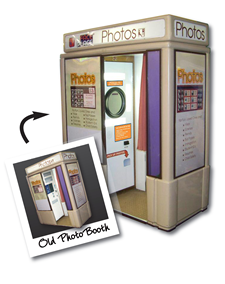Helen Fletcher speaks with Allen Weisberg to see how Apple Industries is moving forward with its product

Apple Industries stems back to its roots of a family run business that repaired and operated coin-operated games and jukeboxes. Established by Abraham Weisberg, who started out as a technician in New York City, he branched out to become a route operator including chemical photo booths in the mix.
As time went on it became obvious to Weisberg that the photo booth business was profitable and an industry that could be expanded upon. Fast-forward to today and Apple Industries has become one of the premier photo booth manufacturers in the world run by Abraham’s son Allen.
Working with over 50 distribution outlets worldwide, Apple continues to seek additional distribution partners all of the time and has in the past, distributed products for other manufacturers, although its focus today is on product it manufactures exclusively.
In the last four years the company has doubled its growth each year and is constantly changing with its focus strongly on software development.
##image2##
"During our time in the industry we have seen the amusement sector slow down," said Allen Weisberg. "As we saw the video game era erode, we have seen the photo booth sector increase dramatically and we believe this phenomenon occurred because the product is replacing the consumer’s desire to be entertained in a way that cannot be satisfied by a coin-op video game or home video game.
"Every time a consumer uses a photo booth they walk away with a product and at the same time they have a fun experience. Every photo taken is a different experience creating repeat uses by the consumer. On the other hand with video game revenue falling and the cost of video games increasing, operators see the stable income of a photo booth as a viable alternative. In addition, the fact that a photo booth may be in operation for 10 to 25 years seals the deal for an operator to make the decision to purchase and be a photo booth operator."
For Weisberg, the most intriguing trend in the photo booth industry is its stability, which continues to astonish everyone. "Photo booths have been around for over 75 years," he said. "It is just recently that the industry is taking notice of this - there is no other machine with a track record like the photo booth. My question is, why did it take so long for the operator to realise this? I guess it is better late than never and we are very grateful that the operator has now realised and is purchasing our booths."
##image3##
Apple Industries plans on releasing four new products for this year and recently presented its patent pending Face Place Double Take photo booth at the Amusement Expo in Las Vegas. Two photo booths in one, the customer may use the traditional photo booth by entering the booth and closing the curtain to take their photo as normal or they can have their photo taken on the outside of the booth. As the customer walks by the photo booth their picture is displayed on a 32ins monitor - the machine then speaks to the customer asking them to take a free photograph.
Featuring cutting-edge technology that allows a customer’s image to be taken while they are walking by the machine, the image is then manipulated into thousands of different photograph images and displayed on the monitor.
"For example," said Weisberg, "one photo may be of the customer with a different hair style, another may be of the customer with a beautiful girl or body builder next to them - or a photo with the customer’s face on a different body. The customer can then choose from these thousands of photographs which photos they’d like to purchase - creating multiple sales rather than just a one photo sale done in a traditional photo booth."
Looking to the future of Apple Industries and the photo booth sector in particular, Weisberg told InterGame: "We see photo booths expanding greatly in the operator’s arsenal of equipment. We believe that the operator never had the choice of a reliable and reasonably priced photo booth before - at Apple we offer such a product."
First published May 2010

